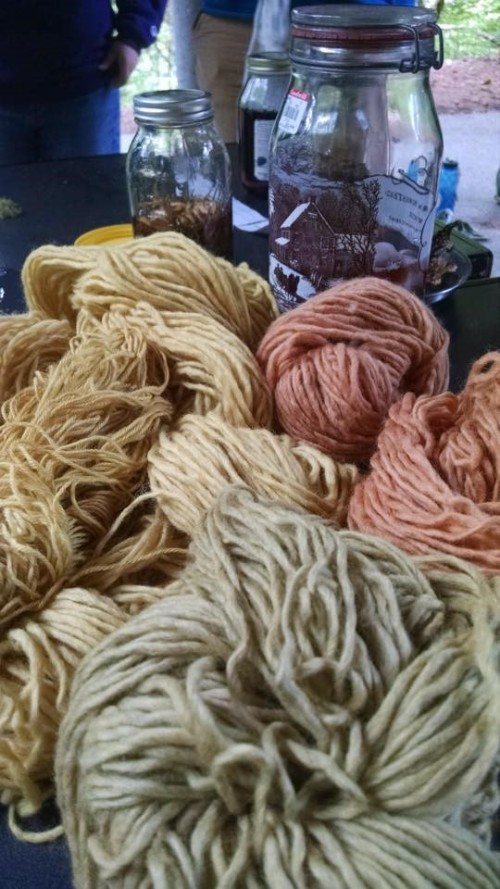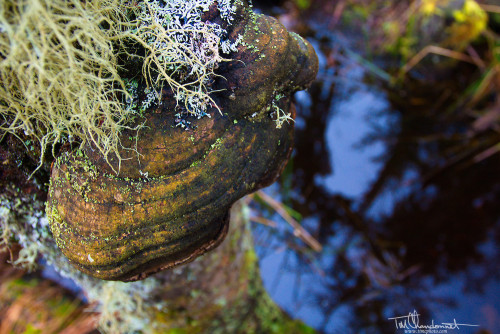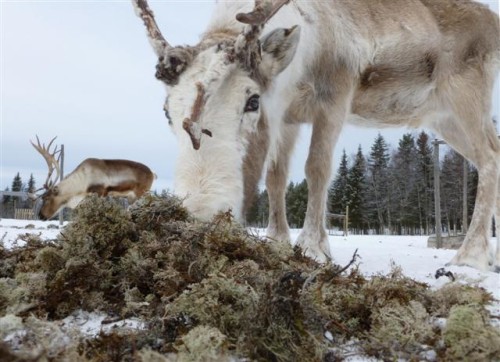Lichen Love: A Natural History of Lichen (Part One)

By Kelly Sleight, graduate student in the institute’s 14th cohort.
There is a low mist in the woods-
It is a good day to study lichens.
-Henry David Thoreau, A Year in Thoreau’s Journal: 1851
The history of lichen and its uses began long before any person had started recording information in written form. The knowledge and use of lichen was spread around the globe and each population used the lichen from their region in a different manner. From food to medicine, fiber to dye, lichen has taken a huge role in history and in the ecosystem. However, it seems to me that lichenologists are few and far between, a very small population working with a vast number of species that seem impossible to distinguish. This must be one of the factors that sparked my desire to learn about lichen. I wanted to learn all the little secrets of this intriguing organism, find out what abilities it has, and what makes them so incredibly diverse. As I delved deeper into the mysteries of the natural world during my graduate residency, lichen pulled at me, and I craved more information. From day one, a particular patch of lichen had inspired my sit spot, the canopies of Witch’s Hair kept me spell bound, and the trees of Old Man’s Beard draped over the Skagit. Thus, I embarked on an endeavor to learn about this amazing organzism.
What is Lichen?
Lichens are curious organisms that are completely unique in structure and classification. Lichen is incapable of being classified amongst much other vegetation because it is technically a composite organism, a partnership between a fungus and an organism capable of photosynthesis, either algae or cyanobacteria, the latter sometimes mistakenly referred to as blue-green algae (Brodo 2001). Because of this, lichen is not connected to the plant kingdom and is in fact more closely related to animals than plants (Wooten 2015). This small organism has had such great evolutionary success that there are now over 14,000 different species in the world that cover about 8% of the terrestrial surface of the earth. Looking closer, there are 3,600 species in North America, and 1,000 in the Pacific Northwest alone (McCune 2010).
Part of the reason for lichen success is due to the many variations it can make using its three major components of fungus, green algae and cyanobacteria. In lichenization, the fungus is always the dominant partner, and a fungus is considered lichenized when it has formed a symbiotic relationship with a photosynthetic partner, a photobiont, for short. It is important to distinguish this symbiotic relationship between the fungus or mycobiont, and the photobiont. There are many mistakes made regarding what is or isn’t a lichen, including algae-covered fungi or parasitic fungi (Brodo 2001).
To simplify this relationship, we often say that an organism is considered a lichen when a fungal partner, or mycobiont, forms a relationship with a photobiont. The mycobiont provides water, minerals, photosynthetic surface, and shelter from environmental factors, while receiving a share of the photosynthesized sugars and carbohydrates. It is interesting to note that in many “true” lichens, the mycobiont and photobiont elements can be separated and grown separately in labs, creating organisms that bear no resemblance to the lichen they were originally (Brodo 2001).
But alas, it is never quite so simple. The most common photobiont species is green algae, however, cyanobacteria can also enter the picture either as a primary or secondary photobiont. If a cyanobacterium is the primary photobiont, the lichen will behave the same as above, however, it’s coloration will differ, becoming a darker colored lichen instead of the light or lime green color we see with a green algae photobiont. When a cyanobacterium enters the mini-ecosystem as a secondary to the primary green algae photobiont it loses its photosynthetic properties. In these cases, the primary photobiont continues photosynthesis and the cyanobacteria becomes a nitrogen fixer (Vitt 1988).
It is also important to consider a few things that lichen is not. Lichen often gets categorized informally with mosses, liverworts, free-living fungi or certain fungi with algal relationships. Many lichens mistakenly carry the name ‘moss.’ Reindeer moss, for example is, in fact, lichen. Several other species of lichen carry common names that refer to them as mosses. Though mosses and liverworts often share habitats with lichen, they are mostly members of the plant kingdom (Brodo 2001).
Lichen Components
Mycobiont
As stated earlier, the mycobiont is the dominant partner in the lichen relationship. When naming lichen, you are essentially naming the fungal component that accounts for the majority of the lichen structure. In the fungal kingdom, most members fall into two phylum, Ascomycetes or Basidiomycota, distinguishable by their mode of reproduction. In general mushrooms are Basidiomycota, whereas molds, mildews, and cup or sac fungus are Ascomycetes. Of the 30,000 species of Ascomycetes, around half are capable of lichenization (Brodo 2001).
Photobionts
There are about twelve genera that represent the green algae in lichen, but only 2-3% of photobionts in lichen are identified to species level (Brodo 2001). In the Pacific Northwest around 60% of lichens share the same species of green algae called Trebouxia (McCune 2010). Cyanobacterium is of a different genera altogether and is distinguishable due to the occurrence of chlorophyll throughout the cell fluid instead of in chloroplasts in green algae (Brodo 2001). Most photobionts become completely altered in lichenization and are difficult to identify.

Lichen Classification
Lichen is typically classified into three or four categories based on growth form. These categories are fruticose, foliose, squamulose and crustose. Fruticose lichen grows erect from their substrate, typically on trees, and shows no difference between the upper and lower surfaces. They are the fastest growing lichens at 1.5 to 10mm of growth per year (McCune 2010). Foliose lichens grow flat on either trees or rock. They have distinguishable upper and lower surfaces, usually with only one photosynthetic side. Squamulose lichen serve as intermediary between crustose and foliose. They appear flat and adhere well to their growth surface, however, are slightly leafy at the edges allowing it to be peeled back away from its substrate. Lastly, crustose lichens grow flush with their substrate and cannot be remove in one piece. They are the slowest growing lichens, some growing consistently at 0.5 mm per year, which allow scientists to get very accurate dating for events between 500-1,000 years old (Wooten 2015).
Lichen Reproduction
Lichen reproduction is a varied and complex undertaking. Since lichen is a symbiotic relationship between two organisms the reproduction can become very complicated, very quickly. Lichen can reproduce asexually or sexually, and sometimes both within the same organism (Brodo 2001). Then, within these categories, lichen has several ways of reproducing.
Asexual reproduction, or vegetative reproduction, can happen in a few different ways. The key factor in vegetative reproduction is that the algal and fungal filaments must reproduce and disperse at the same time. One of the ways it does this is soredia. Soredium consists of an algal body surrounded by fungal filaments that are created in the lichen thallus and then detach to be dispersed by wind, animal, or similar distributer. Fragmentation is another way lichen reproduces asexually. This form is mostly used by fruticose lichen that will become brittle, break off, and grow in a new place. Finally, lichen can reproduce through isidia. Isidia is a combination of soredia and fragmentation, where the lichen will create cylindrical algal body surrounded by fungal filaments that grow on the surface of the lichen then become brittle, break off, and grow in a new location (Brodo 2001).
Sexual reproduction does not require simultaneous dispersal of all the elements of lichen. The mycobiont will reproduce mainly using the method many sac fungi in the Ascomycetes genera use. The mycobiont will form a cup in which spore packets will accumulate. Typically wind or water will disperse the spore packets, which then need to either steal a photobiont partner or wait for algal dispersion to relichenize (Bhat, Dudani, Chandran, & Ramachandra N.D.).
Lichen Diversity
Lichens are some of the most wide spread organisms in the world, ever changing and able to survive anywhere from the poles, to the tropics, to the ocean shore, to the desert. Lichen has even been sent to space and brought back to life after exposure to zero atmosphere (de la Torre 2010). It can erode any surface; create a substrate for new life. Woodland caribou and reindeer eat is as a primary food source; birds use it as nesting material; many animals eat it during winter foraging (Wooten 2015) (Brodo 2001).
It has become incredibly diverse due to its varied locations of growth, nutritional needs, and complex reproductive strategies. Because of this flexibility between lichen species, there is rarely a place where lichen won’t grow. Lichen has become adapted to any situation and is often the first species to settle, especially in places lacking soil.

Lichen as Air Quality Indicator
One of the most fascinating things that I came across in my research was lichen’s relationship to nitrogen and air quality. I had learned that certain lichen species were indicators of clean air, like Lobaria pulmonaria; however, I had no idea about the significance that lichen has on the atmosphere. Lichen is responsible for fixing one-third of the nitrogen in the atmosphere, making it breathable for plants and animals.[1] (Wooten 2015)
Each lichen species has its own tolerance range to the atmospheric and substrate nitrogen or pollution levels. Certain Usneas, Hypogymnias, and Lobarias are very sensitive to nitrogen and pollution, along with many members of the fruticose classification. Evernias, Parmelias, and Melanelixias are moderately tolerant as is typical of the foliose lichen. Xanthorias and Physcias love nitrogen rich areas, and are often found around the dens of rodents or where they excrete (Brodo 2001) (Geiser N.D.).
As nitrogen increases, lichen community composition will shift to high nitrogen tolerant species. There may not be any net loss in the biodiversity of lichen species, however, the ecological interactions become at risk as new lichens move in to a place where the former lichens were needed as winter forage, nesting material, habitat, and nitrogen fixation (Geiser N.D.). An example of this is the disappearance around the I-5 corridor of many nitrogen and pollution sensitive species. Many trees in the area are completely devoid of lichen due to the high pollution rate in the corridor (Wooten 2015).
It is also important to consider the variety of environmental influences that also effect lichen populations. Though their sensitivity to nitrogen is a huge indicator of lichen population and air quality, they also need certain ranges for temperature, moisture, nutrients, substrates, canopy, light, competition and air pollutants. This creates many different factors to account for when studying lichen and their sensitivity to air quality (Geiser N.D.) However, lichen operate on such a delicate balance that when air pollutants enter the equation, metabolic energy used for photosynthesis must be redirected to repair cellular structures and quickly lead to a complete breakdown of the whole organism (Brodo 2001).
[1] Fun fact: One-third of the nitrogen fixing in the atmosphere is done by lichen, one-third by bacteria, and one-third by lightning.


This was an incredible report. Thank you for your mention of a sit spot and thanks for the obvious respect you have for lichen. This was so informative and well written.
t
Is there any way to get the source from the “An example of this is the disappearance around the I-5 corridor of many nitrogen and pollution sensitive species. Many trees in the area are completely devoid of lichen due to the high pollution rate in the corridor (Wooten 2015).”
Enjoying your paper.